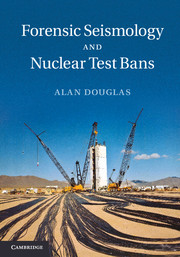Book contents
- Frontmatter
- Contents
- Preface
- Abbreviations and mathematical symbols
- Prologue
- 1 Seismology: ancient and modern
- 2 Statistical solutions to seismological problems
- 3 Seismograms as time series
- 4 Seismographs and seismograms
- 5 Seismometer arrays and processing methods
- 6 Seismogram interpretation and synthesis
- 7 Hypocentres and P travel times
- 8 Seismic magnitudes
- 9 Seismic source identification
- 10 Epilogue
- Appendix A P and S radiation from a double-couple source
- Appendix B Normal equations for analysis of variance
- Appendix C Some uses of the FFT
- Appendix D Anelastic attenuation
- Appendix E The relation of the transient and steady-state responses
- Appendix F Seismometer–galvanometer systems
- Appendix G SNI from summing array recordings
- Appendix H The equations for computing MP filters
- Appendix I Circular arrays
- Appendix J Geometrical spreading when S reflects as sP
- Appendix K The Fourier integral for a dispersed wave train
- Appendix L Tables of explosions and earthquakes
- Appendix M Album of body-wave seismograms
- Appendix N Exercises
- References
- Further reading
- Author index
- Index
Appendix N - Exercises
Published online by Cambridge University Press: 05 March 2013
- Frontmatter
- Contents
- Preface
- Abbreviations and mathematical symbols
- Prologue
- 1 Seismology: ancient and modern
- 2 Statistical solutions to seismological problems
- 3 Seismograms as time series
- 4 Seismographs and seismograms
- 5 Seismometer arrays and processing methods
- 6 Seismogram interpretation and synthesis
- 7 Hypocentres and P travel times
- 8 Seismic magnitudes
- 9 Seismic source identification
- 10 Epilogue
- Appendix A P and S radiation from a double-couple source
- Appendix B Normal equations for analysis of variance
- Appendix C Some uses of the FFT
- Appendix D Anelastic attenuation
- Appendix E The relation of the transient and steady-state responses
- Appendix F Seismometer–galvanometer systems
- Appendix G SNI from summing array recordings
- Appendix H The equations for computing MP filters
- Appendix I Circular arrays
- Appendix J Geometrical spreading when S reflects as sP
- Appendix K The Fourier integral for a dispersed wave train
- Appendix L Tables of explosions and earthquakes
- Appendix M Album of body-wave seismograms
- Appendix N Exercises
- References
- Further reading
- Author index
- Index
Summary
Exercises for Chapter 1
1.1 An observed P signal shows displacements on the vertical and east–west components only; there is no displacement on the north–south component. If the first motion on the vertical-component is up and that on the east–west component is towards the west in what direction is the source?
1.2 Figure N.1 shows the vertical (up–down) and horizontal (east–west) components of a dispersed Rayleigh wave. By plotting on an x–y graph the vertical and horizontal displacements (assuming motion to the east is positive) at the times when the vertical component is a peak, a trough or a zero crossing, sketch the motion of a point on the free surface (the particle orbit) as the wave passes the point of observation. Repeat the exercise assuming motion to the west is positive. Which of the two sketches shows retrograde elliptical motion? Hence, what is the direction to the source?
1.3 If the speed of propagation of the 60 s period component of the Rayleigh wave (FigureN.2) is 3.89 km s−1 and that of the 20 s period component is 2.95 km s−1, estimate the distance of the recording station from the source. The true distance is one of the following: 1000 km, 3000 km, 5000 km or 7000 km. Which one?
[…]
- Type
- Chapter
- Information
- Forensic Seismology and Nuclear Test Bans , pp. 461 - 472Publisher: Cambridge University PressPrint publication year: 2013



